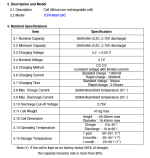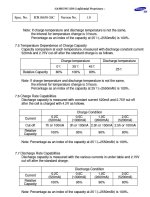desmond007
100 µW
- Joined
- Jan 16, 2017
- Messages
- 9
Hi there,
I'm fairly new here, also new to this subject, so some suggestions about creating a battery pack will be highly appreciated.
My goal is to create a 48v 26ah battery pack. For this, I'm using Samsung 26c 18650 cells. The specs are below.

This is because it's a 2600mah battery I'm doing 13s10p pack. I'm going to use a BMS for this and thinking about using this one. ( http://www.ebay.com/itm/13S-Li-ion-Lithium-Cell-48V-20A-18650-Battery-Protection-BMS-PCB-Board-Balance-/272291298325 )
So my questions are,
1. For the pack first I need to put 10 battery in parallel and 13 of them, right? I mean, 10 battery with parallel connection and then connecting them with series for 48v.
2. To charge the battery I'm going to use a 54.6, 4A/5A charger. Is that okay? What is the maximum ampere charger I can use to charge it? 26A?
3. In above image, I can see that each cell takes around 3 hours to fully charge. So if I connect a 5A charger, each battery will get 5000ma/10 = 500ma, so the charging time will be around 7.8 hours for the pack, right?
4. What the BMS will do for balancing? Will it divide the 54.6v to 13 packs so that each pack can get 4.2 volts? The ampere will be same for each pack, right?
5. I can see that there is also an option to discharge through BMS. If I use that what gonna happen? Will it take 3.7 volts from each 13 battery pack?
6. Can I charge and discharge the battery pack at the same time?
I know all these questions are very basic. But it will be helpful if someone answers it.
Thanks.
I'm fairly new here, also new to this subject, so some suggestions about creating a battery pack will be highly appreciated.
My goal is to create a 48v 26ah battery pack. For this, I'm using Samsung 26c 18650 cells. The specs are below.

This is because it's a 2600mah battery I'm doing 13s10p pack. I'm going to use a BMS for this and thinking about using this one. ( http://www.ebay.com/itm/13S-Li-ion-Lithium-Cell-48V-20A-18650-Battery-Protection-BMS-PCB-Board-Balance-/272291298325 )
So my questions are,
1. For the pack first I need to put 10 battery in parallel and 13 of them, right? I mean, 10 battery with parallel connection and then connecting them with series for 48v.
2. To charge the battery I'm going to use a 54.6, 4A/5A charger. Is that okay? What is the maximum ampere charger I can use to charge it? 26A?
3. In above image, I can see that each cell takes around 3 hours to fully charge. So if I connect a 5A charger, each battery will get 5000ma/10 = 500ma, so the charging time will be around 7.8 hours for the pack, right?
4. What the BMS will do for balancing? Will it divide the 54.6v to 13 packs so that each pack can get 4.2 volts? The ampere will be same for each pack, right?
5. I can see that there is also an option to discharge through BMS. If I use that what gonna happen? Will it take 3.7 volts from each 13 battery pack?
6. Can I charge and discharge the battery pack at the same time?
I know all these questions are very basic. But it will be helpful if someone answers it.
Thanks.


